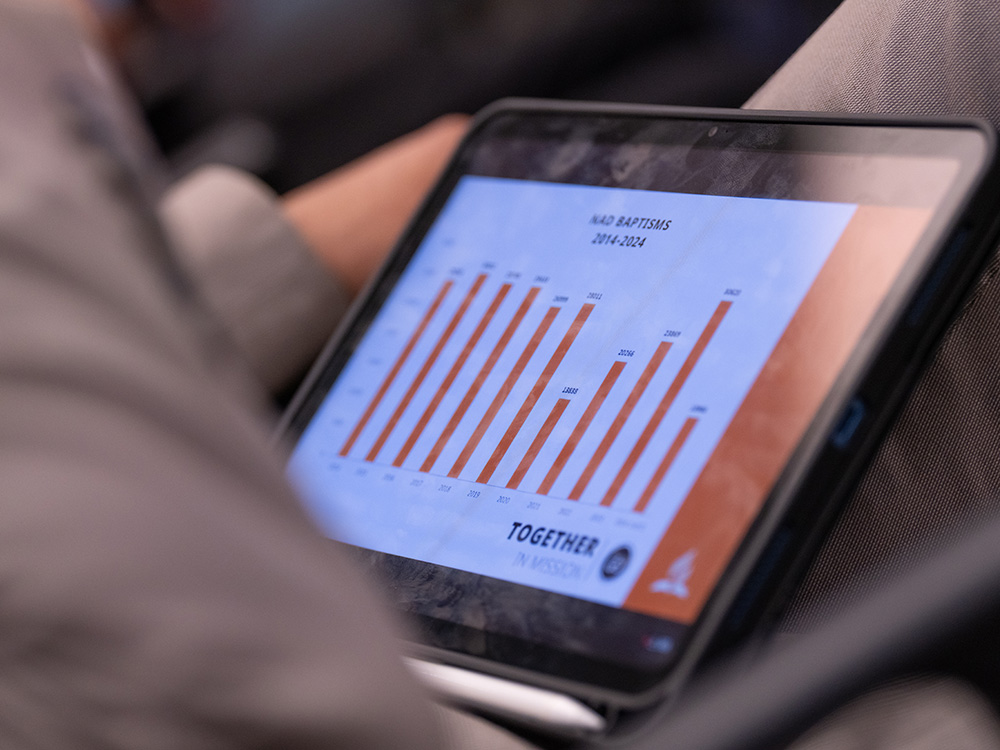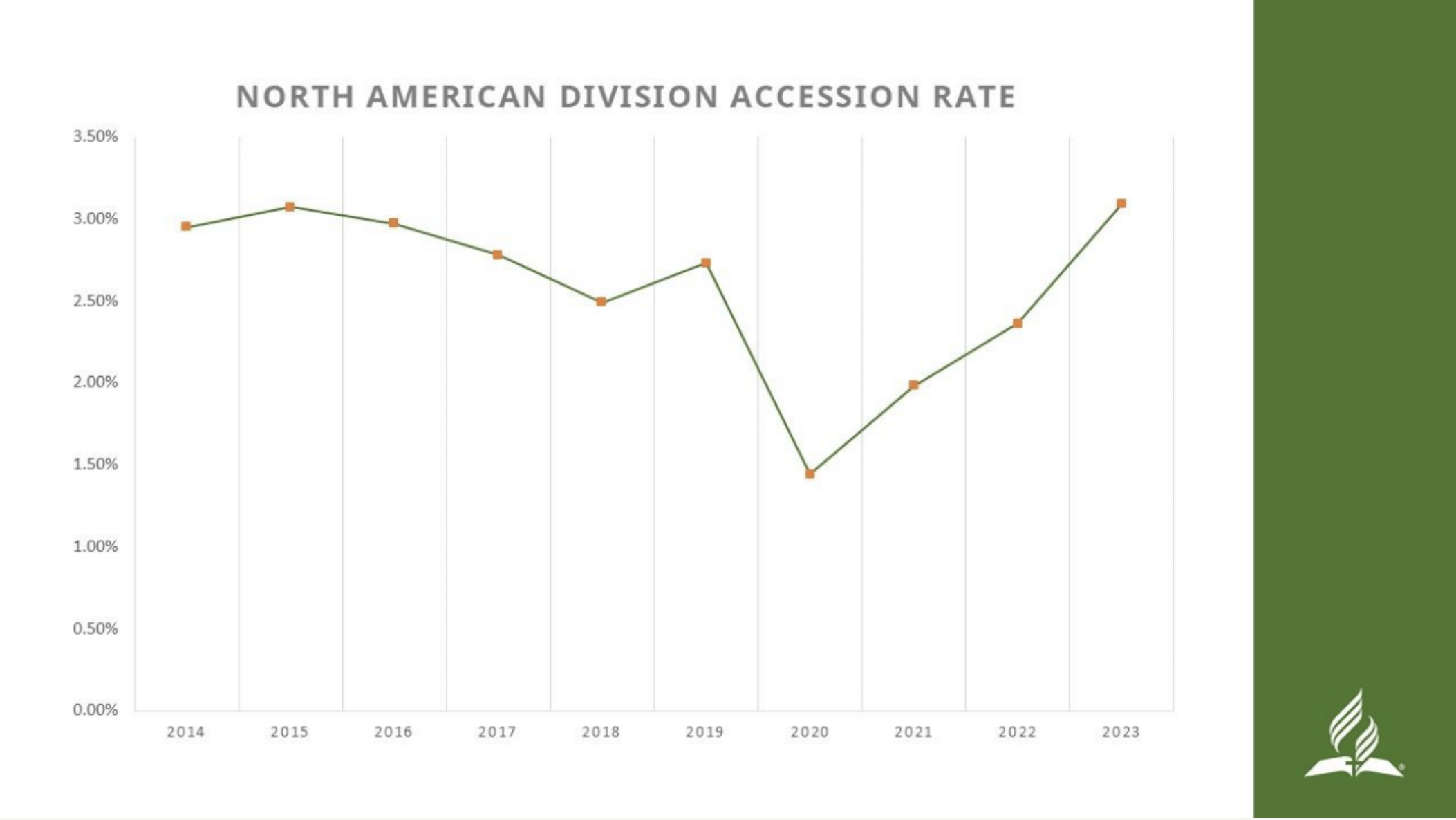
Kyoshin Ahn, executive secretary for the North American Division, gives his annual report at the 2024 NAD Year-End Meeting morning business session on Nov. 3. Photo by Pieter Damsteegt/North American Division
Kyoshin Ahn, executive secretary for the North American Division, presented his report to kick off day three of the division’s 2024 year-end meeting. To begin, he read the list of everyone in the departments of the secretariat, thanking the team for their service and their contributions to the report.
(For the purposes of Ahn’s report of the state of the church in the NAD, all data represents numbers at the close of the second quarter of 2024, unless otherwise specified.)
Current membership of the church is 1,268,572, a net gain of more than 10,000 members from 2023. Ahn projects there will be closer to a 20,000 net gain in membership by the end of 2024. In 2023, the church baptized 30,000 people, and thus far in 2024, it has seen 14,000 baptisms, with a projection of at least 30,000 total by the end of the year.
“It is my sincere prayer that we will see more than 40,000 baptisms in 2025,” Ahn stated, then amended, “Am I aiming too low? Yes! I pray for 50,000 baptisms in 2025!”
In response, the room erupted in a chorus of “Amens.”

Photo by Pieter Damsteegt/North American Division
Membership Demographics
Looking at the demographics of the church, Ahn reported that 53 percent are female, 41 percent are male, and 6 percent did not indicate gender in their responses. These numbers have not changed compared to previous years.
Almost half of the church’s baptized members are between 30 and 59 years of age; nearly a third are over 60. Interestingly, the median and mean age of current NAD church members is the same, at 49.

A pie chart showing the age ranges for Adventists in North America, taken from the 2024 NAD Year-End Meeting report by Kyoshin Ahn, NAD executive secretary on Nov. 3.
According to a 2024 survey, the NAD’s membership is 33 percent white, 30 percent Black, 23 percent Hispanic, 7 percent Asian, 2 percent Pacific Islander, and 2 percent multiracial. The full 2024 diversity survey report is available here.
“We have a very diverse division, and no one ethnicity is dominant,” Ahn commented. “The Adventist church is very often remarked upon by outside entities for being the most diverse denomination in the U.S.”
The NAD’s membership represents 5.4 percent of the 23 million members of the worldwide church. Though this number was previously 6 percent, Ahn pointed out this does not mean the NAD church is shrinking, it simply reveals the incredible recent growth rate of the church in other parts of the world.
“We have a steady increase in congregations within our division,” Ahn commented, stating a current total of 5,775 churches and 894 companies. During the last decade, the NAD has added a total of 400 congregations to its number, for a total of nearly 6,700. Also steadily increasing is accession, or additions to church membership by baptism and profession of faith per 100 members. In 2023 that number was 3.1, a number which has been climbing annually since 2020.

Chart showing the NAD accession rate through the first two quarters of 2024, as presented in the executive secretary's report at the NAD year-end meeting on Nov. 3.
A look at the net growth rate of the church in the NAD shows a significant dip in membership in 2022; Ahn explains this is due to membership audits across the division, with more accurate numbers being reported to update records. “There was a resurgence in 2023,” Ahn pointed out; “the current trajectory of our growth rate looks like we’re returning to pre-2016 numbers.”
When the floor was opened for questions and comments, Tracy Wood, director for Youth and Young Adult Ministries for the NAD, commented that it looks as though there has been some growth in the numbers of members under the age of 24.
“We’ve been trying to change the narrative that all young adults are leaving the church,” Wood said. “Many may not attend church regularly, but they’re not asking to have their names removed, so that’s a win.”
At this time, Ahn showed a video report about mission ministry within the NAD; a full report on the content of that report is available here.
Opportunities for Meaningful Interactions
Another video report followed, presented by Brian Ford, director of eAdventist Membership Services focused on ethnic, racial, and cultural diversity in the NAD church. In the report, Ford cited the 2015 Pew Research study that showed the incredible diversity of the Adventist Church in the U.S.

Graphic provided by eAdventist
Michael W. Campbell, director of Archives, Statistics, & Research, reported via video on the NAD’s need to focus on Native American and Indigenous populations across the NAD. He also shared that the fourth-largest religion in the U.S. right now is Buddhism.
“In 2023, the U.S. granted 60 thousand refugees amnesty, and Canada did the same for 140 thousand,” Campbell said. This means the cultural makeup of certain parts of North America has shifted in a significant way. “We need to be aware and discerning of these changes as we do our best to share Jesus with the world.”
Ahn agreed, and in closing the secretary’s report, he said the church must acknowledge North America as the largest unchurched English-speaking mission field in the world.
“Do we have coordinated approaches to effectively address these challenges?” Ahn asked the room. “If yes, praise the Lord! If not, how can we develop an effective mission strategy to work in these changing landscapes? Are we prepared to interact with people meaningfully when they show up and show interest?”
Ahn admitted he was asking hard questions without having definitive answers, but asserts they were all valuable questions.
“We must consider our strategy together and we must do it seriously,” Ahn stated. “We are still called to continue the mission as we were 150 years ago. Jesus says to us, in John 4:35, that the fields are ready for harvest — just look outside your door! Look at the NAD field! We need to see the mission field as it actually is.”
Questions and comments included a request for the issue of diversity and inclusion in the church to be addressed in a focused discussion, particularly in how it impacts the ability of local churches to minister to their communities.
Benjamin Jones, president of South Central Conference, commented, “We’re a rural church serving an urban, diverse city. The churches are growing, but the tithe base is not, so we’re absorbing members without resources to handle it. We need to talk about how these figures impact that reality.”
Other commenters implored those present not to assume that focus on NAD mission work means “the rest of the world can take care of itself,” and that the church make ministry on public college and university campuses a strategic emphasis going forward.
